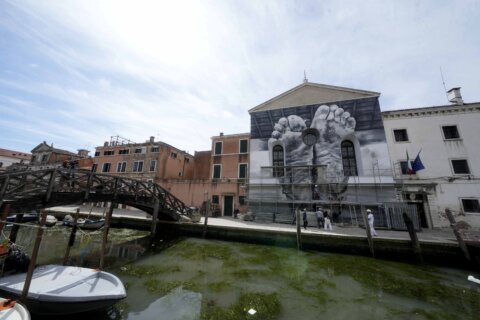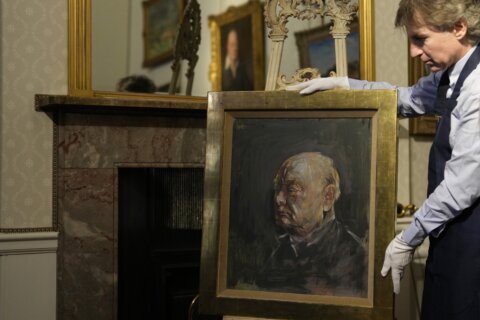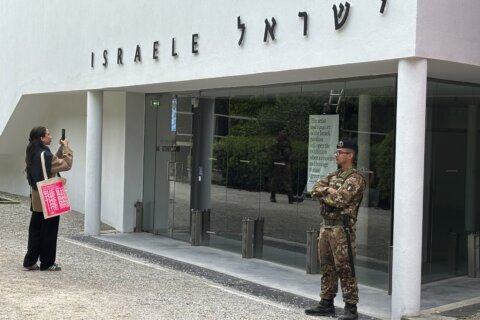NEW YORK (AP) — Rosencrantz and Guildenstern are dead, all right, but not as Shakespeare imagined. No Norwegian prince arrives to seize the Danish throne. And to be or not to be is not the question.
So it goes in the latest operatic adaptation of the most famous play in the English language. “Hamlet,” with music by Brett Dean and libretto by Matthew Jocelyn, opens at the Metropolitan Opera on Friday, the final new production in the company’s comeback-from-COVID season.
This is “Hamlet” as you’ve never heard it, set to an orchestral score that includes an accordion, tinfoil, plastic bottles, sandpaper and stones knocked together.
And Jocelyn’s version of the play sounds at times as if he’d taken the various texts that survive and put them through a Mixmaster, even shifting lines away from one character and giving them to another. It’s enough to give Shakespeare purists fits.
Yet to paraphrase a line from the play, there’s method in his madness.
“I told Brett at the outset there’s no such thing as ‘Hamlet,’” Jocelyn said in an interview. “There were three versions published in his lifetime and every production has always been a conflation. It felt to me that if we went back to the original sources we would have the raw material to make our own compilation, but in a more radical way.”
Tenor Allan Clayton, who performed the title role at the work’s 2017 premiere at England’s Glyndebourne Festival and is repeating it at the Met, said that “what Matthew has done very cleverly is to upend some of the expectations.
“Because the benefit of doing ‘Hamlet’ is that people can say, ‘Oh, I’ll come and see that,’” Clayton said. “They’ve got a way into it, as opposed to any other contemporary opera which might seem less approachable. He takes that expectation and he doesn’t destroy it completely, but he sort of throws curveballs in.”
For example, Clayton, said in the opera “My first line is “ … Or not to be,” and the audience goes, ‘Oh, wait, that doesn’t come in until much later.’”
And when Hamlet does eventually deliver that soliloquy, it’s not the familiar version but rather based on the first published text of the play, the disputed First Quarto.
So instead of beginning: “To be or not to be: that is the question,” we get “…or not to be. To be….ay, there’s the point.” And later, instead of “To die; to sleep .. perchance to dream! Ay there’s the rub,” we hear “To die, to sleep – is that all? Ay, all. No! To dream – ay, there it goes.”
Besides rearranging and reassigning chunks of the text, Jocelyn had to make drastic cuts to get a play that would take nearly six hours to perform completely down to an opera of less than three.
“The decision was to make it a family story,” Jocelyn said. So he and Dean jettisoned the character of Fortinbras, the Norwegian prince who claims the throne at the end of the play. They also dropped a subplot in which the sycophantic courtiers Rosencrantz and Guildenstern accompany Hamlet to England and are murdered en route. Instead, they survive until the final scene when Hamlet slashes them with a poisoned sword.
Focusing more narrowly on Hamlet’s agonizing over whether and how to seek revenge on his uncle for murdering his father helped Dean create what he called “an aural psychodrama, getting inside Hamlet’s head.”
To do this, he made the “sound world quite all-encompassing,” placing two trios of clarinet, trumpet and percussion in side balconies, along with occasional choristers.
When a percussionist knocks two stones together, Jocelyn said, “We’re feeling what it is to be inside Hamlet’s head because those rocks are exploding in his head.”
There’s also a “semi-chorus” of eight singers in the orchestra pit, which Dean said “work as a resonance chamber, an echo of some of the things you hear spoken or sung on stage.”
He even has Ophelia sing a few lines standing in an upper balcony.
“A lot of people who weren’t opera fans told me they loved sitting in the middle of the audience and feeling like they were in a cinema soundscape,” Clayton recalled from the Glyndebourne performances. “Sort of like Dolby Surround sound.”
Despite the sometimes eccentric instrumentation, Dean doesn’t consider his score particularly difficult for a newcomer to opera to appreciate.
“We composers like to think we’re the newest thing since sliced bread,” he said, “But it’s not the most challenging thing that one will necessarily hear in avant garde terms. It has a lyricism.”
First performed in 1602, “Hamlet” and its influence are inescapable more than 400 years later. While the opera is playing at the Met, across town an acclaimed production from London is opening at the Park Avenue Armory. The Public Theatre is presenting the Pulitzer Prize-winning “Fat Ham,” a tale inspired by Shakespeare about a Southern gay Black college student. The current movie “The Northman” is based on the tale of Amleth, which was a source for Shakespeare. Even “The Lion King,” which has been on Broadway for nearly a quarter-century, takes key plot elements from the play.
Yet though numerous composers have created operas based on “Hamlet,” only Ambroise Thomas’s 1868 five-act French-language version has kept a toehold in the active repertory. (The Met last performed it in 2010, after an absence of more than a century.)
Even before the Met production, Dean’s “Hamlet” has shown signs of staying power, with performances in Adelaide, Australia and Cologne, Germany. It will also be produced at the Bavarian State Opera in Munich, Germany, next summer.
The Met’s production, also starring soprano Brenda Rae as Ophelia, baritone Rodney Gilfry as Claudius and mezzo-soprano Sarah Connolly as Gertrude and conducted by Nicholas Carter, will be the final Live in HD production of the season, broadcast to movie theaters worldwide on June 4.
Copyright © 2024 The Associated Press. All rights reserved. This material may not be published, broadcast, written or redistributed.







